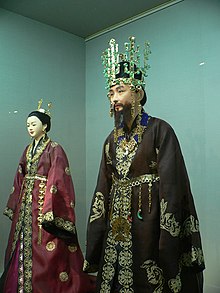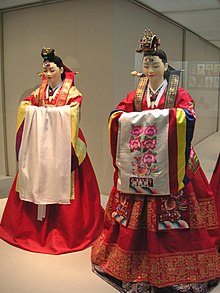Hanbok: Difference between revisions
Leeheonjin (talk | contribs) |
No edit summary |
||
| Line 1: | Line 1: | ||
''[[http://www.example.com link title]] |
|||
== |
|||
== Headline text == |
|||
== |
|||
{{Cleanup|date=December 2007}} |
{{Cleanup|date=December 2007}} |
||
{{Infobox Korean name |
{{Infobox Korean name |
||
| Line 111: | Line 115: | ||
[[th:ฮันบก]] |
[[th:ฮันบก]] |
||
[[tl:Hanbok]] |
[[tl:Hanbok]] |
||
[[zh:韓服]] |
[[zh:韓服]]'' |
||
Revision as of 22:59, 30 December 2007
[link title] ==
Headline text
==
| Hanbok | |
 | |
| Korean name | |
|---|---|
| Hangul | [한복 or 조선옷 ] Error: {{Lang}}: text has italic markup (help) |
| Hanja | [韓服 or 朝鮮옷 ] Error: {{Lang}}: text has italic markup (help) |
| Revised Romanization | Hanbok or Joseon-ot |
| McCune–Reischauer | Hanbok or Chosŏn-ot |
Hanbok (South Korea) or Chosŏn-ot (North Korea) is the traditional Korean dress. It is often characterized by vibrant colors and simple lines without pockets. Although the term literally means "Korean clothing", hanbok today often refers specifically to Joseon Dynasty-style semi-formal or formal wear that is worn during traditional festivals or celebrations.
History
Hanbok in the Three Kingdoms period


Some of the basic elements of today’s hanbok, namely the jeogori shirt, baji pants and the chima skirt were probably worn at a very early date, but it was not until the Three Kingdoms period (57 BC–AD 668) that the two-piece costume of today began to evolve. Short, tight trousers and tight, waist-length jackets were worn by both men and women during the early part of the period, as evidenced by ancient tomb paintings of Goguryeo tombs. This basic structure remains relatively unchanged to this day.
Toward the end of the Three Kingdoms period, noblewomen began to wear full-length skirts and hip-length jackets belted at the waist and noblemen began to wear roomy trousers bound in at the ankles and a narrow, tunic-style jacket cuffed at the wrists and belted at the waist.
Also during this period, Tang China silk robes were adopted by royalty and officials. This tradition eventually leads to Gwanbok, the traditional clothes of government officials of pre-modern Korea.
Goryeo period
When Goryeo Dynasty (918–1392) signed a peace treaty with the Mongol Empire, Goryeo kings married Mongolian queens and government officials adopted Mongol fashion. As a result of this influence, the chima skirt was shortened, as was the jeogori, which was hiked up above the waist and tied at the chest with a long, wide ribbon (instead of belted) and the sleeves were curved slightly.
Joseon period

In Joseon Dynasty, jeogori of women's hanbok became gradually tightened and shortened. In the 16th century, jeogori was baggy and reached below the waist, but by the end of Joseon Dynasty in the 19th century, jeogori was shortened to the point that it did not cover the breasts, so another piece of cloth(heoritti) was used to cover them. At the end of 19th century, Daewon-gun introduced Magoja, a Manchu-style jacket, to Korea, which is often worn with hanbok to this day.

Chima was full-skirted and jeogori was short and tight in the late Joseon period. Fullness in the skirt was emphasized round the hips. Many undergarments were worn underneath chima such as darisokgot, soksokgot, dansokgot, and gojengi to achieve a desired silhouette. Because jeogori was so short it became natural to expose heoritti or heorimari which functioned like a corset. The white linen cloth exposed under jeogori in the picture is heoritti.
The upper classes wore hanbok of closely woven ramie cloth or other high-grade lightweight materials in warm weather and of plain and patterned silks the rest of the year. Commoners were restricted by law as well as resources to cotton at best. The upper classes wore a variety of colors, though bright colors were generally worn by children and girls and subdued colors by middle-aged men and women. Commoners were restricted by law to everyday clothes of white, but for special occasions they wore dull shades of pale pink, light green, gray, and charcoal. Formally, when Korean men went outdoors, they were required to wear overcoats known as durumagi which reach the knees.
Head dresses

Both males and females wore their hair in a long braid until they were married, at which time the hair was knotted: the man’s in a topknot sangtu on the top of the head and the woman’s in a ball just above the nape of the neck. Women of high social backgrounds and gisaeng wore wigs (gache). Like their western contemporaries Koreans considered bigger and heavier wigs to be more aesthetic. Gache was banned by the court in the late 18th century. In 19th century yangban women began to wear jokduri, a small hat that substituted gache. However gache still enjoyed vast popularity in giseng circles.
A long pin, or binyeo, was thrust through the knotted hair of the woman as both a fastener and a decoration. The material and length of the binyeo varied according to the wearer’s class and status. Women wore a jokduri on their wedding day, and wore an ayam for protection from the cold.
Men wore a gat, which also varied according to class and status.
Occasions

Hanbok are classified according to their purposes: everyday dress, ceremonial dress and special dress. Ceremonial dresses are worn on formal occasions, including a child's first bmade for shamans and officials.
Modern Hanbok
These days modern hanboks for children only consist of two or three pieces and can be put on easily. They are usually made of less expensive fabrics since they are only worn once or twice a year during the bigger holidays like Chuseok and Seolnal. Children are dressed up in hanbok also on the day one year after they were born called dol.[1][2]
Official clothing
Hanbok for royal court
-
Gonryongpo: business attire for king
-
Hongryongpo: everyday clothes for king
-
Hwangryongpo: everyday clothes for king. Gojong began to wear the clothes.
-
Tongcheonggwan and Gangsapo
-
Hwangwonsam:everyday clothes for queen
Gwanbok
Gwanbok (hangul:관복 hanja:官服) is a general term for business attire of government officers which were initiated to wear from Silla kingdom. There were several types of gwanbok according to status, rank, and occasion.[3][4]
-
Gwanbok in the Goryeo period, 11th century.
-
Gwanbok in the Goryeo period, 14th century.
-
Gwanbok in the 15th century
-
Gwanbok in the 17th century
-
Heuk danryeongpo in the late 18th century
-
Geumgwan Jobok in the late 18th century
-
Sibok in the late 18th century
Hanbok for men in yangban class
-
Waryeonggwan and Hakchangeui in 1863.
-
Bokgeon and Simeui in 1880.
-
Black Bokgeon and blue dopo in 1880.
-
Outdoor wear for men.
Hanbok for women
-
Women's hanbok consists of chima and jeogori.
-
A typical hanbok for women. Late 18th century.
-
Giseng with a style. Early 19th century.
-
A rare picture of yangban women. One can see the characteristics of late Joseon period hanbok.
See also
References
- ^ "돌" (in Korean). empas Korean dictionary. Retrieved 2007-11-29.
{{cite web}}: Cite has empty unknown parameter:|1=(help)CS1 maint: unrecognized language (link) - ^ "dol". Julia's Cook Korean site. Retrieved 2007-11-29.
{{cite web}}: Cite has empty unknown parameter:|1=(help) - ^ "Veteran Korean Designer Enchants Smithsonian Museum". Chosun Ilbo (English Edition). 2007-5-18. Retrieved 2007-11-29.
{{cite web}}: Check date values in:|date=(help); Cite has empty unknown parameter:|1=(help) - ^ "관복 (官服)" (in Korean). empas/Encykorea. Retrieved 2007-11-29.
{{cite web}}: Cite has empty unknown parameter:|1=(help)CS1 maint: unrecognized language (link)




















